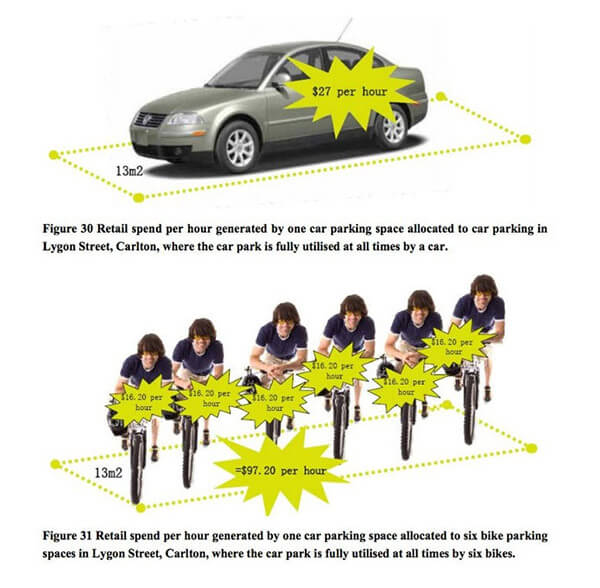Autumn Gear Guide
Find inspiration in our Gear Guide that will keep you out on your bike through wind or rain.
Download NowSix reasons business owners should support their bike riding customers.
In an increasingly health-conscious and environmentally-aware society, the sight of bicycles chained to urban street furniture has become as commonplace as the morning rush for coffee. But these two-wheeled transporters signify more than a shift towards sustainable commuting and an active lifestyle — they represent a lucrative demographic that businesses are eager to attract. Here, we delve into the economic, environmental, and community benefits that cyclists bring to local businesses. From increased spending power to fostering a sense of community, cyclists are the unexpected lifeblood revitalizing businesses across our cities.
How often does it happen that you’re driving down a busy downtown street and you suddenly notice a cute-looking cafe you’ve never seen before, so you pull over, pay for parking, and go check out their menu and pick up a coffee? My guess is almost never. People driving cars overwhelmingly get in their cars at point A and arrive at a predetermined point B without making any unplanned or spontaneous stops. So businesses that largely depend on spontaneous patronage – such as restaurants, cafés, clothing stores, or other boutiques, as opposed to say, Ikea – lose out on a significant potential customer base when they’re located on a street that is unfriendly to people on bikes and pedestrians. While pedestrians are the most likely to make spontaneous stops, people on bikes also ride slowly enough to notice the businesses in the first place, and bike parking is hassle-free enough that they’ll be happy to pull over. The bonus? People on bikes can carry more goodies home than those on foot.
Gone are the days when rent-a-car had the monopoly on tourist transportation. Bike share is booming in cities the world over, hotels are increasingly adding bicycles to their list of amenities, and cities are promoting their bike-friendliness as a strategy to attract tourism. In growing numbers, tourists are opting for bicycles as their transportation-of-choice when they arrive in a new city. Most tourist centers and bike rental shops will send their clientele away with a list of great bike rides and a map of bike routes in the city. Pity the business that isn’t located along those routes.
While somebody is unlikely to walk or take public transit across town just to check out a cute vintage shop they’ve heard about or try a new café, people on bikes will go the distance. Bike riding is 4x faster than walking, in most cases faster than public transit, and depending on traffic conditions, often faster than driving a car. More importantly, riding a bike is fun. People who ride bikes love riding bikes, so a 30-minute ride to a different neighborhood just to try the samosas at a new Indian restaurant is not a burden, but a fun weekend activity.

Infographic from the University of Melbourne study.
Business owners along proposed bike lane routes frequently lament that the loss of car parking will mean the end of their business. In fact, quite the opposite is true. A recent study by the Transportation Research Board of the National Academies found that bike lanes and bicycle parking act as catalysts for local economies by increasing the human capacity of available road space. If the road is only safe for people in cars, then your customer base is quantitatively limited to the people in cars who can find parking. Bike infrastructure enables more people to share the same amount of space, thereby significantly expanding your potential customer base. A study conducted at the University of Melbourne determined that while drivers spend more per hour than people on bikes ($27 to $16.70 respectively), 6 bikes could fit into one car parking space, which would yield a potential $97.20 an hour if the car parking were to be converted to bike parking.
We’ve all done it. You go to the store intending to buy staples, but while waiting in line at the checkout you casually flip through a magazine and eventually toss it in with your purchases, then, on second thought, yeah you better grab that chocolate bar as well. This is well-documented consumer behavior – spontaneous “temptation spending” – that affects any retail business’ bottom line. A study in Muenster, Germany analyzed consumer spending patterns at three large supermarkets and department stores. They determined that people on bikes shop more regularly than people on cars – 11 times per month compared to 7 times for motorists, thereby increasing their exposure to temptation on every trip. Which perhaps explains the final point.
Studies conducted on consumer spending by mode of transportation in Davis, CA, Bern, Switzerland, San Francisco, CA, Toronto, ON, Auckland, New Zealand, New York City, NY, and Portland, OR all reached the same conclusion: people on bikes spend more money. In some cases, people on bikes spent the same per trip as people in cars, but in all cases, people on bikes spent more overall in long-term spending because they made more trips.
Find inspiration in our Gear Guide that will keep you out on your bike through wind or rain.
Download Now
Would love for Arlington TX to be a bike friendly city.
Another point is missing: People on bikes save money they would usually spent on the car. That money is likely to be spent otherwise, at least partially in local businesses.
In the extreme case, they didn’t even buy a car, but even if they own one, they save money on gas and repairs.
Comments are closed.